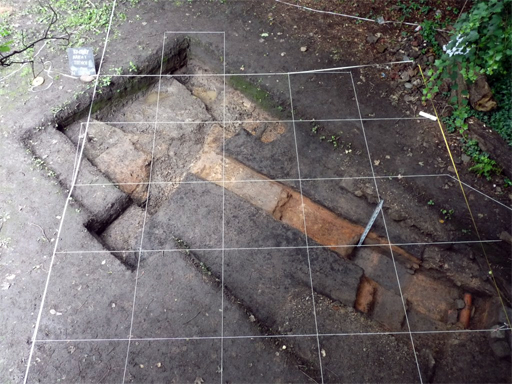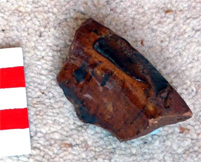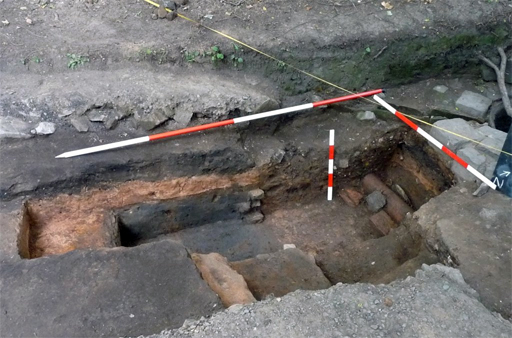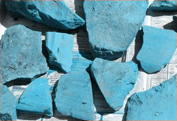
Our summer trip last month got off to a dodgy start when our hired mini-bus got inadvertently locked in the hire company's compound. Hasty rearrangements involving car sharing, meant we were able to continue our journey without too much hassle.
It turned out to be a beautiful summer's day and despite the early hick-up, we arrived in York, in good time for our guided tour of the Hungate site. This huge site, which lies on the east side of the city, was for many years a run down area of the city. Slum clearances, however, in the 1930's & 40's has meant the site has lain empty every since. Archaeologist arrived in 2007 when the area was selected for development. As it was quite close to the Coppergate site expectations were high of finding further evidence of Viking York. In 1068 William the Conqueror flooded this area to provide a moat for his nearby castle; however this water logging ensured the survival of many Viking remains in the Coppergate area. The Hungate site is further out on higher ground and, therefore, has not produced the same amount of Viking material. The archaeologists, however, have not been disappointed as they have discovered a late Roman cemetery and even possibly a mausoleum. The work is scheduled to continue for another year and archaeologists are confident of further revelations.
In 1068 William the Conqueror flooded this area to provide a moat for his nearby castle; however this water logging ensured the survival of many Viking remains in the Coppergate area. The Hungate site is further out on higher ground and, therefore, has not produced the same amount of Viking material. The archaeologists, however, have not been disappointed as they have discovered a late Roman cemetery and even possibly a mausoleum. The work is scheduled to continue for another year and archaeologists are confident of further revelations.
After a pleasant picnic lunch in the grounds of St Mary's Abbey, we took the opportunity to visit a section of Roman walling which survives behind the Multangular Tower in the Abbey grounds. This is an impressive section showing Roman construction techniques. What is particularly interesting about the section, however, is the insertion of a stone tower sometime in the 7th century. Known as the Anglian Tower (see team photo) it is incredibly rare as it is possibly the only secular structure to have survived in Britain from the entire Anglo Saxon period.
Before leaving St Mary's we were entertained by a troupe of actors re-enacting the aftermath of the Battle of Wakefield (1460). The reenactment included some armed hand-to-hand combat (not the best thing to be doing on such a warm day in full armour). The rest of the afternoon was free but most of us ended up (after some difficulty finding it) at the newly refurbished Barley Hall. This 15th century manor house was only rediscovered in 1984 when the area was scheduled for redevelopment. Excavations revealed the original structure including the original floor and earth of the great hall and an external stairway to a great chamber on the first floor. The complex has now been lovingly restored and set up as the dwelling of a 16th century nobleman, Master William Snawsell who lived in it at that time.
One advantage of car travel is flexibility and some of our group took advantage of this by staying late to have a tour of the City walls before setting off home.
Rectory Update
 Our work on this site is progressing quite nicely and is now beginning to produce some interesting results. Norman Redhead (GMAU) and Ian Miller from Oxford Archaeology North came to visit last month and both were impressed by our efforts. Ian was able to confirm that, much of the pottery we have uncovered dates from the 17th and 18th century - with a few even dating back to the 13th or 14th century. Ian commented on the distinct lack of late Victorian pottery. This probably reflects the fact that the grounds were enclosed when the present hall was built in 1875. Our work on this site is progressing quite nicely and is now beginning to produce some interesting results. Norman Redhead (GMAU) and Ian Miller from Oxford Archaeology North came to visit last month and both were impressed by our efforts. Ian was able to confirm that, much of the pottery we have uncovered dates from the 17th and 18th century - with a few even dating back to the 13th or 14th century. Ian commented on the distinct lack of late Victorian pottery. This probably reflects the fact that the grounds were enclosed when the present hall was built in 1875.
Our excavations have uncovered a well-made dirt track (under a late 19th century garden path), but we have not been confident that this is the old Frog Lane we have been looking for. We expected the road to be paved and to be much wider (on the 1849 map it is shown as 7 metres wide). However Ian was quite happy for this track to be the old lane, as paving with stone sets apparently only came in in the late 1860's. Norman suggested that the reason for the narrowness of the road at this point could be because of the insertion of the water feature on the north side (far right in this photo) and suggested we cut a section right across the site to prove it.
We are now well on with the section and it seems he was right (well partially). The road has been truncated on the north side. Not however by the water feature, but by a trench cut into it for a drain (and maybe something else as we have yet to reach the bottom). As can been seen in this section the dirt track continues beyond the trench and underneath the sets around the water feature (unfortunately we aren't able to determine how far it goes because of the trees). The section has also revealed that the dirt track is constructed on a bed of compacted sand (which can also be seen in the section under the water feature). However here it lies on top of a soft dark brown sedimentary layer - could this be the fill of the moat which appears in 16th century reports? (a piece of pottery from this layer has been confirmed by Ian as being late 16th century). The section has also revealed that the dirt track is constructed on a bed of compacted sand (which can also be seen in the section under the water feature). However here it lies on top of a soft dark brown sedimentary layer - could this be the fill of the moat which appears in 16th century reports? (a piece of pottery from this layer has been confirmed by Ian as being late 16th century).
This piece of Midland yellow, which is probably 17th century, is actually a 'second' (glaze from another pot as dripped onto the rim before firing). Ian thinks this is evidence that this type of pottery was being produced in the area - as seconds are not normally sold beyond the area where they were produced. If this is true, it's the first evidence of the pottery being manufactured in Wigan from this date.
For more details visit our website Forum: - and if you want to get involved contact myself or a committee member at our next meeting. 
National Museums Liverpool
It seems this august institution is under threat of closure due to central government cuts. If you think this is ridiculous (as I do) and want to voice your opinion, there is an on-line petition. It will be presented to the government in October.
Next Meeting
Wednesday 1st September in the concert room of the Upper Morris Street Working Men's Club (off Greenough Street), starting at 7.30 pm as usual. This month's speaker is Martin Charlesworth - an old favourite of ours whose knowledge of the Persian Empire knows no bounds. His talk is enigmatically entitled 'Something from the East' but I'm sure it will be just as good as his previous ones.
Hope to see you there - BA
|



